New Delhi: The military standoff between the Indian and Chinese militaries that escalated from border rows began about two years ago in May 2020 while the conflict between superpower Russia and former Soviet member Ukraine is well into its third month after that fateful dawn of February 24 when the Russian military juggernaut drove into Ukraine.
The still-unresolved and protracted nature of the Ladakh military standoff and the Ukraine conflict raises questions on the currently-accepted global military paradigm — also accepted by the Indian military establishment — that all future wars will be short, intense and swift.
It has prompted thinking that India’s military establishment may take a relook at the Joint Doctrine of the Indian Armed Forces (JDIAF) that was formulated last in 2017. Reports indicate that the strategic planning department of the Shimla-based Army Training Command (ARTRAC), one of the seven commands of the Indian Army, is already studying the ongoing conflicts in detail.
On Thursday, the issue received focus again when Indian Air Force Air Chief Marshal VR Chaudhari pointed out during a seminar on logistics called LOGISEM VAYU-2022: “In the force, space and time continuum, there would be a need for us to prepare for short swift wars as well as be ready for a long drawn standoff akin to what we are seeing in Eastern Ladakh.”
Traditionally, the IAF — envisaging the worst case scenario of a two-front war — maintains a state of combat readiness primed for a 10-day-long battle in case of a possible war with Pakistan and 15 days in case of such a scenario with China with the IAF’s Directorate of Air Staff Inspection (DASI) playing a key role in ascertaining preparedness with fully stocked up weapons, missiles and alert radar systems.
Till 1999, India’s India’s War Wastage Reserves (WWR) — the reserve of ammunition to meet the requirements of intense war or a full-scale war for the Armed Forces — was maintained for 40 days which was cut to 20 and then to 10 days. But after the border row with China escalated, in 2020, the WWR was again raised to 15 days.
Also read: India increased military expenditure by 0.9 pc in 2021; China by 4.7 pc: SIPRI report
The JDIAF 2017 elaborates on the basic fundamentals of power and excellence in war-fighting across the full spectrum of conflict and puts out in its narrative the best way to execute anything in an optimised manner with existing capabilities, capacities, concepts, structures, mechanisms, practices and crucial availability of resources.
The JDIAF 2017 document had pointed out: “The character of conflict has varied with time, yet it has endured. Technology has been a major driver to the evolution of the character of conflict. Today’s stand-off precision munitions with satellite control systems have altered the physical component of conflict. The character of future wars is likely to be ambiguous, uncertain, short, swift, lethal, intense, precise, non-linear, unrestricted, unpredictable and hybrid.”
The IAF chief also called for an integrated road and rail management plan and to explore the feasibility of increased containerisation and use of civilian wide bodied aircraft during times of conflict as “during contingencies, roads and rail heads would be choked due to simultaneous movement of Indian Army along the same axes”.



